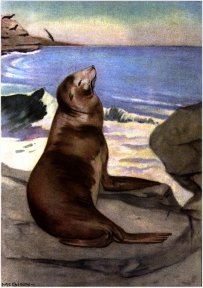California Sea Lion
| Order | Pinnipedia |
| Family |
Otariidae |
| Genus & Species |
Zalophus californianus |
| Length |
Males, 7 feet. Females, 6 feet. |
| Weight |
Males 600 pounds |
| Sexual Maturity |
Males, 5-7 years. Females, 4-5 years |
| Mating season
| May-June in California. October-December in the Galapagos
|
| Gestation | 11 months |
| Litter size | One young |
| Habit
| Sociable in large colonies |
| Call |
Barks, roars, and yelps |
| Diet |
Octopus, squid and fish |
| Lifespan |
10-15 years. Up to 20 in captivity |
The sea lion is sociable and lives in colonies which
may number in the thousands, especially
during the mating season.
The sea lion divides its time between resting on shore and hunting
for food in the ocean. Despite its heavy, awkward-looking body, the
sea lion can move quickly
on land with the use of its flippers.
When entering the water, the sea lion dives in head first,
often
in a group of twenty to thirty animals. It seems to be able to
gauge the depth of the water
and dives accordingly. Underwater,
the sea lion's ears and nostrils close, and it is capable
of
remaining in the water many minutes before surfacing to breathe.

Sea lions breed from May to August. The breeding grounds, called
rookeries, are situated on
beaches and offshore islets. Soon after
the young are born, mature bulls compete to establish
territories.
They use threatening gestures and fight only as a last resort. A
harem of
females and young is established by each mature male.
During mating, the bull has no time to
feed and must survive on
his reserve of blubber. About 3 weeks after her pup is born, the
sea
lion cow is ready to mate again. But she continues to suckle
her young for about 6 months.
The California sea lion
has a remarkably big appetite. An average size animal must consume
about 14 percent of its body weight in food every day. The sea
lion hunts by chasing its prey
through the water or diving down
to the ocean bottom and searching among the rocks with its
muzzle.
It feeds mainly on octopus, squid, and fish. Sea lions have
excellent underwater
vision and hunt their prey mostly by sight.
The well-developed muscles on its muzzle may also
help it to
locate prey by picking up vibrations in the water.
In the early nineteenth century large numbers of sea lions were
killed on the coasts of
California. The blubber of the dead
animals was used as a source of oil, and the skins
were used for
making glue. Today California sea lions are regarded for their
intelligence
and are well known for the playful behavior they
display in captivity. Sea lions are
popular attractions in zoos,
circuses, and marine parks.

| DID YOU KNOW? |
| Sea lions are known as eared seals because, unlike true seals who
only have ear
openings, sea lions have small external ears |
| A California sea lion can swim at a speed of up to 25 miles per
hour. This is faster
than any other species of sea lion, seal or walrus |
| The male sea lion's territory extends into the water, as well as on
land. When
defending his underwater territory, he will bark, sending up chains of air bubbles
as a warning
to rival males |
Information is Copyright
IMP BV/IMP Inc.
Wildlife Fact File
|